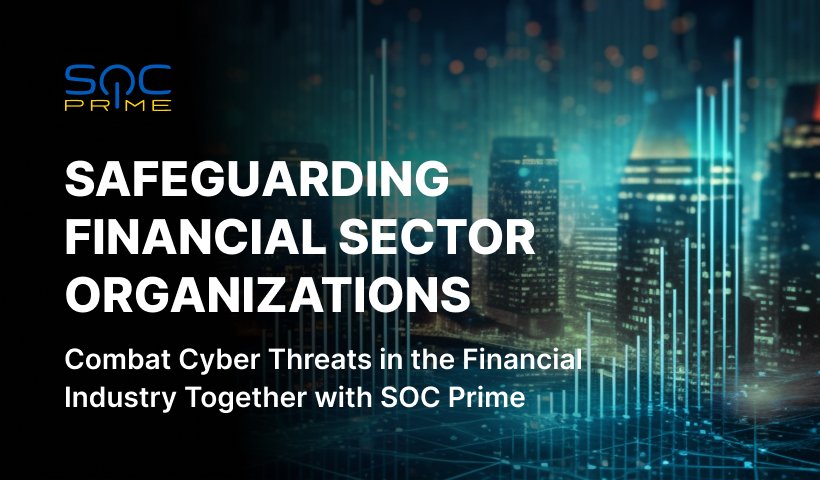Strengthening Cybersecurity in the Finance Industry Equipped with SOC Prime’s Solutions

Table of contents:
The financial sector, the keystone of the global economy, has become increasingly digitized in recent years. While this transformation brings efficiency and convenience, it also exposes financial institutions to many cybersecurity challenges. Threat actors, ranging from sophisticated hacker groups to opportunistic individuals, are constantly targeting the financial sector, seeking to exploit vulnerabilities for financial gain.
Overview of the Cyber Threat Landscape for the Financial Sector
The financial industry is facing various cybersecurity challenges due to its growing reliance on technology and the digitization of financial services. Financial institutions are prime targets for cyber attacks, with trillions of dollars of transactions and vast amounts of sensitive data at stake. Let’s deep dive into the prominent cybersecurity issues faced by financial institutions:
- Data breaches. Financial institutions handle large amounts of sensitive personal and financial data, making them attractive to hackers. Data breaches can lead to the exposure of customer information, including names, addresses, Social Security numbers, and financial account details. This information can be used for identity theft, phishing, and other malicious activities. The global average cost of a data breach in 2023 reached $4.45 million, displaying a 15% increase over 3 years.
- Phishing attacks. Phishing is considered the biggest cybersecurity risk by financial businesses. It is the most common form of cybercrime, with an estimated 3.4 billion spam emails sent every day. Phishing attacks against financial institutions such as banks held the highest share at 23.2%.
- Ransomware. After the latest investigation, Sophos reported a significant increase in ransomware attacks on the finance industry: 64% compared to 55% in 2022. This might be a troubling sign for banks, investment firms, and other financial services organizations, as only 14% of finance companies managed to stop an attack before data was locked.
- Regulatory compliance. The financial industry is heavily regulated. For instance, The General Data Protection Regulation (GDPR) and the New York Department of Financial Services (NYDFS) Cybersecurity Regulations require financial institutions to implement strong cybersecurity measures. Non-compliance can lead to significant penalties.
- High-value transactions. Financial transactions involve large amounts of money, making fraudulent transactions and unauthorized transfers attractive to cybercriminals. Phishing, social engineering, and other tactics can be used to manipulate individuals or processes and initiate unauthorized transactions.
- Advanced Persistent Threats (APTs). APTs are sophisticated, targeted attacks that take control of the network and go undetected for long periods of time. These attacks are highly focused on financial institutions to gain access to valuable data and financial systems.
The True Cost of Cybersecurity Incidents
The financial industry faces unique challenges when calculating the cost of cybersecurity incidents. Beyond monetary losses, which average around $5.9 million per data breach in the financial sector (28% higher than the global average), there are other important factors to consider in review.
Growing regulatory concerns are playing a role in how financial firms respond to cyber attacks and where they invest to reduce overall risk. Take a look at common threat vectors: while 48% of financial attacks originate from malicious actors, human error accounts for 33%. Phishing and compromised credentials take the top positions among initial attack vectors, at 16% and 15%, respectively. If attackers are successful, they often gain access to millions of transactions and customer records: the average cost for breaches of 50 million records or more now exceeds $300 million.
Globally, it took companies 204 days to identify and 73 days to prevent a breach. These numbers are slightly better in the financial sector, with breaches identified in 177 days and resolved in 56 days on average. However, these numbers highlight the need for swift detection and response to minimize potential damage.
Elevating Cybersecurity Resilience for Financial Institutions Backed by SOC Prime
In the ever-evolving landscape of cybersecurity threats, financial institutions must remain vigilant. The most dangerous are incidents that damage the integrity of financial data, such as records, algorithms, and transactions. The malicious actors behind these attacks include not only bold criminals — such as the Carbanak group aka FIN7, which has targeted financial institutions since at least 2013 and stole more than $1 billion. There are also states and state-sponsored attackers. For example, APT38 is a North Korean threat group that specializes in financial cyber operations. Active since at least 2014, APT38 has targeted banks, financial institutions, casinos, cryptocurrency exchanges, SWIFT system endpoints, and ATMs in at least 38 countries worldwide. Significant operations include the 2016 Bank of Bangladesh heist, during which APT38 stole $ 81 million, as well as attacks against Bancomext (2018) and Banco de Chile (2018); some of their attacks have been destructive.
Well-known Lazarus Group is another North Korean state-sponsored cyber threat group that has been attributed to the Reconnaissance General Bureau. The group has been active since at least 2009 and was reportedly responsible for the November 2014 destructive wiper attack against Sony Pictures Entertainment as part of a campaign named Operation Blockbuster by Novetta. The malware used by Lazarus Group correlates to other reported campaigns, including Operation Flame, Operation 1Mission, Operation Troy, DarkSeoul, and Ten Days of Rain. North Korean group definitions are known to have significant overlap, and some security researchers report all North Korean state-sponsored cyber activity under the name Lazarus Group instead of tracking clusters or subgroups, such as Andariel, APT37, APT38, and Kimsuky.
SOC Prime Platform offers a range of ready-to-deploy detection content that can help safeguard against phishing attacks and detect malicious activity associated with cybercriminal groups, like APT19, APT38, Carbanak, and Lazarus Group which target banking organizations. Sign up for SOC Prime Platform or log in with your existing account to reach the entire collection of Sigma rules to detect critical threats challenging financial institutions. Click the Explore Detections button below to access the relevant detection stack.
Leveraging SOC Prime’s Attack Detective, the industry-first SaaS for collective cyber defense built on zero-trust architecture, organizations can continuously improve their cybersecurity posture against risks and breaches most relevant to the financial sector. While the use of Uncoder AI, the IDE for active threat-informed defense, equips organizations with a trusted environment for streamlined detection code creation, continuous improvement, and automated bi-directional query translation across 64 SIEM, EDR, XDR, and Data Lake query formats to simplify detection content migration in multi-tenant environments. Organizations can rely on Uncoder AI as a fully private tool, ensuring no code logging or data sharing with third parties, which is critical for security-conscious organizations in the financial industry.
Having SOC Prime’s Threat Detection Marketplace at hand, security practitioners can rely on advanced search engine to browse for the ready-to-deploy behavioral detection algorithms and explore context on any cyber attack or threat, including zero-days, APTs, CTI and ATT&CK references, and Red Team tooling. With access to industry-first dataset of 300,000+ detection rules and threat hunting queries, users have relevant detections always at hand to outsmart and overspeed adversaries.
To stay updated on the emerging threats, cyber defenders stay tuned to the world’s largest rule feed on the latest TTPs used by adversaries in the wild, as well as proactive methods not yet linked to cyber attacks. Also, users can rely on collective cyber defense switching to recommended sorting offering a feed of rules most relevant to financial industry and geography.
As the financial industry continues to invest in the protection of its digital assets, SOC Prime serves as a trusted partner in the relentless battle against cyber threats. With SOC Prime Platform’s proactive approach, financial institutions can navigate the complexities of the digital world, secure their operations, and maintain the trust of their customers and stakeholders. At a time when financial resilience equals cybersecurity strength, each organization requires valuable support in this ongoing battle for digital security.



